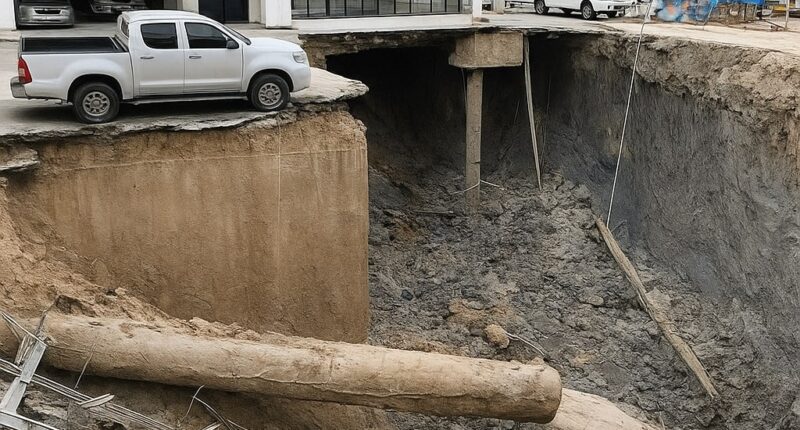In recent years, Bangkok has faced a puzzling and alarming phenomenon: sudden sinkholes appearing in busy streets and residential areas. These collapses not only pose a threat to public safety but also raise questions about what lies beneath the bustling capital of Thailand. Let’s explore the causes, consequences, and possible solutions behind Bangkok’s sinkhole mystery.
Understanding the Bangkok Sinkhole Phenomenon
Sinkholes are depressions or holes in the ground caused by the collapse of surface layers into underground cavities. While they are not uncommon in certain parts of the world, Bangkok’s geology and rapid urban development have made the city increasingly vulnerable.
Geologists have noted that the city is built on soft clay soil, which is prone to subsidence. Combined with heavy rainfall and intensive construction, Bangkok is essentially sitting on unstable foundations. When the ground can no longer support the pressure, sudden collapses occur.
Possible Causes of the Sudden Collapse
1. Weak Soil Foundation
Bangkok sits on a deep layer of alluvial clay. This weak soil compresses under the weight of buildings, traffic, and infrastructure, making the ground susceptible to sudden shifts.
2. Excessive Groundwater Extraction
For decades, industries and residents have relied heavily on underground water. Over-extraction lowers the groundwater table, leaving voids that can trigger sinkholes. Although regulations have reduced pumping in recent years, the damage to subsurface stability remains.
3. Heavy Rainfall and Flooding
Monsoon rains are a regular feature in Bangkok. Intense downpours erode underground layers and wash away soil, creating hidden cavities. When the surface can no longer hold, it collapses abruptly.
4. Construction and Infrastructure Stress
Bangkok’s rapid urbanization has led to continuous roadworks, subway expansions, and high-rise projects. The constant drilling and vibrations weaken already fragile soil, making sinkhole formation more likely.
Impacts on the City and Residents
Sinkholes can cause immediate damage to vehicles, roads, and buildings. In some cases, they have swallowed entire cars and disrupted traffic for hours. Beyond property damage, they raise concerns about safety and highlight the urgent need for better urban planning.
Economically, repairs and preventive measures cost millions of baht annually. Psychologically, residents live with the fear that the ground beneath them might give way without warning.
How Bangkok is Responding
Authorities are taking several steps to manage the risk:
-
Soil Monitoring Programs: Using sensors and ground surveys to detect early signs of subsidence.
-
Reduced Groundwater Usage: Encouraging surface water reliance and regulating illegal pumping.
-
Urban Planning Adjustments: Implementing stricter guidelines for construction in vulnerable zones.
-
Public Awareness Campaigns: Educating citizens on how to respond in case of sudden collapses.
Conclusion: Can Bangkok Prevent Future Sinkholes?
Bangkok’s sinkhole mystery is not entirely unsolvable. The combination of natural geology, human activity, and climate factors creates the perfect conditions for sudden ground collapses. However, with smarter urban planning, stricter groundwater management, and continuous monitoring, the city can reduce risks.
As Bangkok continues to grow, its ability to adapt to the hidden challenges beneath its streets will determine whether these sinkholes remain a rare mystery—or a recurring urban nightmare.







